Gunkel, Dieter. "Musical evidence for low boundary tones in ancient Greek." CHS Research Bulletin 9 (2021). http://nrs.harvard.edu/urn-3:hlnc.essay:GunkelD.Musical_Evidence_for_Low_Boundary_Tones_in_Ancient_Greek.2021.
Abstract
Several scholars have posited a word- or clitic group-final low boundary tone for ancient Greek. The boundary tone would motivate accentual phenomena, including the conversion of a word-final acute to a grave phrase-internally as well as the diachronic pitch-peak retraction that led to circumflex accents on penultimate syllables. The effects of such a low boundary tone should be audible in ancient Greek non-strophic vocal music, where there is a greater-than-chance correlation between the pitch movement of the text and the movement of the melody to which it is set. Specifically, the turning point between falling and rising melody should center around the word final mora or syllable. The present study shows that this holds true in the Delphic hymns, even when the effects of accentual low tones are factored out. In other words, there is solid musical evidence for a word- or clitic group-final low boundary tone in ancient Greek.
Report
1. Low boundary tone
Boundary tones are intonational pitch accents that appear at the beginning or end of prosodic constituents. As Gussenhoven notes (2004:135), they are so frequently reported at the beginning and/or end of higher-level prosodic constituents such as intonational phrases that they may be universal. Boundary tones are likewise documented for lower-level prosodic constituents in some languages. In Turkish, for example, there is a low boundary tone at the beginning of every prosodic word (Ipek and Jun 2013).
Beginning with Devine and Stephens’ 1996 The Prosody of Greek Speech (= PGS), several analyses of ancient Greek accentuation posit a low boundary tone at the end of the word, or word plus enclitic(s) (PGS 154, 180, 189, 191; Itô and Mester 2017; Revithiadou 2018).[1] This low boundary tone Lω has been invoked to explain several phenomena.
The first of these is “lulling,” i.e. the phrase-internal conversion of a word-final acute to a grave accent. As exemplified in the Homeric formulae in (1), within the major phrase,[2] a word-final acute is realized as such before an enclitic (a);[3] elsewhere it is “lulled” to a grave (b).
(1) (a) ἀγαθός περ ἔων agathós per éɔːn ‘despite being brave’
(b) ἀγαθὸς Μενέλαος agathos menélaːos ‘brave Menelaus’
If a Lω existed in ancient Greek, it would have immediately followed the H of the word-final acute in cases such as (1b = 2a), but not in cases such as (1a = 2b), where an enclitic followed the word and the Lω was associated with the end of that word-plus-enclitic unit.
(2) (a) agathoHsLω
(b) agathoHs perLω
Lulling may be understood as the lowering[4] or deletion[5] of the high tone of the acute H before the immediately following Lω (PGS 181). It would thus be type of “tonal crowding avoidance.” On the lulling as lowering scenario, realizing the high tone of the acute lower would compress the tone range and ease the transition. On the lulling as deletion scenario, the deletion would remove the transition altogether. Both strategies are attested in other languages.[6]
The putative Lω has also been invoked to explain the “sōtêra rule.” The accent of a penultimate syllable in ancient Greek is realized as a circumflex if and only if the penultimate syllable contains a long vowel or diphthong and the vowel of the final syllable is short (3ab); otherwise, the accent is realized as an acute (3cd). The rule applies both to forms with persistent, i.e. lexically inherent, accent (3ac) and to forms with recessive, i.e. phonologically derived, accent (3bd).
(3) (a) σωτῆρα sɔːtɛ̂ːra ‘saviour:ACC.SG’
(b) πολυπῖδαξ polupîːdaks ‘having many springs:NOM.SG’.
(c) σωτήρων sɔːtɛ́ːrɔːn ‘saviour:GEN.PL’,
(d) ἀνθρώποις anthrɔ́ːpoi̯s ‘human:DAT.PL’.
Historically, the sōtêra rule involved the retraction of the pitch peak from relatively late to relatively early in a long vowel or diphthong in forms such as those given in (4). To roughly represent the peak timing in, we can rewrite acute-accented long vowels and diphthongs as VV́, and circumflex-accented ones as V́V.
(4) (a) *sɔɔtɛɛ́ra > sɔɔtɛ́ɛra (cf. Vedic -tár-)
(b) *woíkos > (w)óikos (cf. Vedic véśaḥ ‘house’)
The peak retraction may be understood as another a form of tonal crowding avoidance. The retraction would have given the speaker more time to execute the transition from the accentual H to the Lω (PGS 189, Gunkel 2015).[7] This would fit into the broader development of Greek roughly as follows. The Greek circumflex was not inherited, but arose in the prehistory of the language when an acute-accented vowel contracted with the following vowel, which bore the post-accentual fall in pitch (V́V > V̂ː), e.g. in the dative singular of first-declension nouns of the type φορ-ᾶι = phor-âːi̯ (Jasanoff 2004).
(5) *-áh2ai̯ > *-áai̯ > -âːi̯
The sōtêra rule arose afterwards, and perhaps only in some dialects.[8] Learners of the language perceived the earlier peak and ensuing fall in forms such as (4ab) as the circumflex accent that already contrasted with the acute, at least on long-voweled, word-final syllables, thanks to contractions of the type in (5). In Ohala’s terms (1993), circumflex accents on penultimate syllables arose via a hypocorrective sound change.
The putative Lω may have played a small but significant role in Greek. If it existed, the most direct evidence should be in the fragments of non-strophic vocal music, where the melodies provide something like pitch tracks for the texts they are set to. The goal here is to provide an initial description of the musical evidence for and against Lω from the Delphic hymns.
2. The Delphic hymns
The Delphic hymns (DAGM 20, 21) are the two most important pieces of nonstrophic vocal music in ancient Greek, thanks to their length, their age, and the fact that they are preserved as inscriptions.[9] They were performed in 127 BCE at the Pythaid festival in Delphi by the poets Athenaeus and Limenius, who belonged to an Athenian guild of musicians, poets, and actors. Each hymn is a paean that celebrates the foundational myth of the Pythian sanctuary, Apollo’s slaying of the serpent that had occupied the place before the god’s arrival. The music of the paeans is not strophic but articulated into sections called “paragraphs.” The texts are in paeonic meter (⏕ ⏑ ⏕),[10] except for the prayer that closes Limenius’ composition, which is in Aeolic meter.
In the Delphic hymns and other pieces of nonstrophic vocal music, there is a non-accidental correlation between pitch movement in the text and the movement of the melody. There is general agreement that three generalizations hold.[11] They are formulated by Probert (2003:20) as follows.
A. The accented syllable of a word is usually sung on a note no lower than that of any other syllable in the word.
B. On long vowels that take two notes the first note is usually higher if the syllable has a circumflex, but the second note if the syllable has an acute.
C. A final syllable with a grave accent (as written in our printed texts) is sung on a note no lower than that of any other syllable in its word, but no higher than the accented and pre-accented syllables of the following word.
These three generalizations are concerned with the setting of accented syllables per se (B), accented syllables relative to other syllables within the same word (A), and grave-accented syllables relative to other syllables within the same word as well as pre-accentual syllables in the following word (C). They corroborate non-musical evidence that pitch peaked over acute-accented syllables, and that it peaked and fell again over circumflex-accented ones.
The scholars who produced the generalizations were naturally focused on the setting of accented syllables, since we have independent evidence for their pitch properties. In considering the settings of accented syllables in relationship to surrounding syllables, their findings already point in a clear direction: the generalizations should not be understood as three rules that the poets followed in order to set accented syllables, rather they reflect the poets’ more general interrelation of the pitch movement of the text and the musical melody. Thus, studying the settings in nonstrophic vocal music does not only provide information about the phonetic nature of the accents, it also permits us to reconstruct the movement of pitch between the accents, e.g. the pre-accentual rise and post-accentual fall, and the position of the turning point between falling and rising pitch.
In thinking about this, it is helpful to compare similar traditions in other languages, i.e. vocal music where there is a higher-than-chance correlation between the melody of speech (tone) and the melody of song (tune). There is now a fairly robust literature on “tone-tune association” that facilitates the comparison.[12] From that literature (e.g. Schellenberg 2012, McPherson and Ryan 2018), I will adopt a useful classification of the ways in which a tonal transition (Level, Rising, or Falling — capitalized below) may be set to a musical transition (level, rising, or falling — lower case below). We can distinguish three types of transition settings. First, there are three “parallel” settings, in which level tone is matched by level tune, rising tone by rising tune, and falling tone by falling tune (Ll, Rr, Ff). Second, there are four “oblique” settings (shaded light gray), in which rising or falling tone is set to level tune, or level tone is set to rising or falling tune (Lr, Lf, Rl, Fl). Third, there are two “opposing” settings (dark gray), in which rising tone is set to falling tune and vice versa (Rf, Fr). These are shown in Table 1.

While generalization (A) is not formulated with this classification of transition settings in mind, we can nevertheless infer from it that parallel and oblique settings are more frequent than opposing settings in this type of ancient Greek vocal music, at least if we assume (as usual) that the pitch peak of a word occurs during the acute- or circumflex-accented syllable.
3. The setting of trisyllables with medial acute
It would be interesting to know more about the frequency of parallel, oblique, and opposing settings. In order to get a sense of this, we can examine how trisyllables with an acute on the medial syllable are set to music in the Delphic hymns, e.g. μεγάλου (20.18), χρυσέα (20.15), ναέτας (21.36). Where no melisms are involved, there are two melodic transitions, i.e. from the note of the first syllable to that of the second, and from the note of the second syllable to that of the third. In the setting of μεγάλου (6), for instance, the first melodic transition is rising (one semitone, from G to Ab), and the second transition is falling (three semitones, from Ab to F).[13]
(6) μεγάλου (20.18)
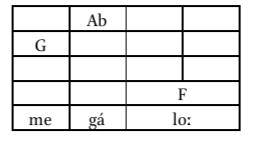
There are twenty-two medially accented trisyllables with two transitions in the Delphic hymns.[14] As shown in Table 2, the two transitions are symmetrical. Transition 1 is ca. seventy percent rising, ca. 30 percent level, and never falling. Transition 2 is ca. seventy percent falling, ca. 30 percent level, and never rising.

In this data set, then, assuming that pitch rose to the peak of the acute-accented syllable and then fell again, we see that roughly seventy percent of the transitions are parallel, roughly thirty are oblique, and none are opposing. Since the goodness-of-fit in transitions is ranked parallel > oblique > opposing, it seems likely that the numbers reflect the poets’ preferences.
When we consider the two transitions (t1 and t2) in combination, as in Table 3, we see that there are four combinations: rising-falling (parallel-parallel), rising-level (parallel-oblique), level-falling (oblique-parallel), and level-level (oblique-oblique).

Examples of the four combinations are given in (7), in order of descending frequency.
(7) (a) Rising-falling: δειράδα (21.23)
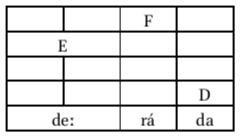
(b) Rising-level: αἰόλον (20.23)
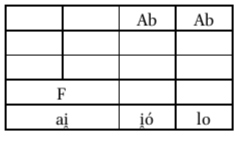
(c) Level-falling: ἐφέπων (20.8)
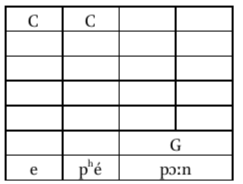
(d) Level-level: προφαίνεις (20.20)

Given a close correlation between tone and tune, in the aggregate, the settings in the Delphic hymns should provide something like pitch tracks for the language. In this dataset, on average, transition 1 is a rise of 1.2 semitones and transition 2 is a fall of 3.1 semitones. For trisyllables with a medial acute accent, then, we can reconstruct — as expected — a pre-accentual rise in pitch to the peak of the acute followed by a post-accentual fall in pitch. We can add to this that the post-accentual fall is roughly two and a half times as steep as the pre-accentual rise. The steeper fall is likely due, at least in part, to declination.[15]
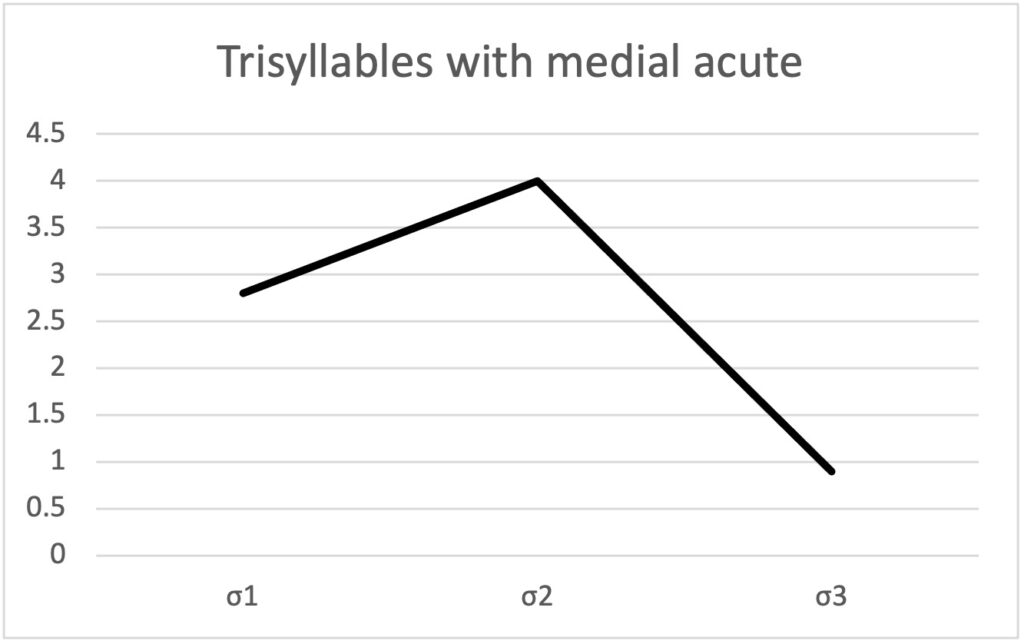
The settings of trisyllables with a medial acute that are mapped to melisms add some detail to the picture. There are seven in the Delphic hymns whose settings are fully preserved. In all seven, the first syllable is set to a rising melism (e.g. 8a). In two, the third syllable is set to a melism as well. In one case, it is falling (8b), in the other, it is rising (8c).
(8) (a) ἀμπέχει (21.12)
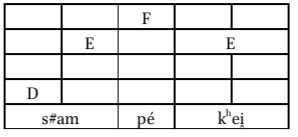
(b) αἰόλοις (20.14)
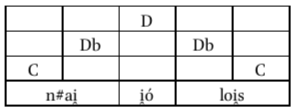
(c) Δελφίσιν (20.6)
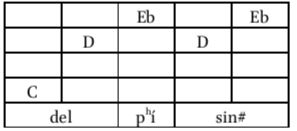
So far, I have been tacitly assuming that the pre-accentual rise starts at the beginning of the word, and the post-accentual fall ends at the end of a word (plus enclitic). The seven rising melisms over the initial syllable corroborate that assumption: the rise from the first to the second mora of the first syllable would be a parallel setting like the rise from the first to the second syllable in the non-melismatic forms, or the rise from the second mora of the first syllable to the second syllable in the melismatic ones. One of the two falling melisms (8b) would corroborate it as well. The setting of Δελφίσιν (8c) raises a question. Do we have to do with an opposing setting, where the post-accentual fall in pitch continues through the final mora of the word, but the tune rises from the penultimate to the final mora? Or does the setting reflect the turning point between falling and rising pitch, in which case it would occur at the penultimate mora of the word?
As pointed out by Allen (1973:245f.), in Vedic Sanskrit, the turning point between a post-accentual fall and a pre-accentual rise is not tied to word boundary. In Allen’s example from the Rigveda urūṇasā́v asutṛ́pā (RV 10.14.12), the post-accentual fall occurs over the first syllable of the second word, and the falling-to-rising turning point occurs over the syllable after that. Using H for high pitch, F for falling, L for low, and # for word boundary, we can represent the approximate pitch movement over the relevant syllables as in (9).
(9) °sā́v asutṛ́°(RV 10.14.12)
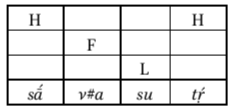
Vedic shows us two things. First, it is not a linguistic universal that the turning point between falling and rising pitch must align with word (or clitic group) boundary. Second, in a cognate and closely related accentual system, that turning point is not tied to word boundary. After some further illustrations of settings in §4, we turn to an investigation of the turning point between falling and rising melody and pitch in §5.
4. Further example settings
The setting of μαντεῖον (DAGM 20.8) provides a further example parallel settings and additionally involves a circumflex-accented syllable set to a falling melism. The first syllable man is heavy and set to a melism that rises one tone (i.e. two semitones) from C to D. The melody then rises another semitone to the first mora of the second syllable têi̯. That Eb is the melodic peak. The circumflected syllable têi̯ is heavy and set to a falling melism Eb D. The melody then falls another tone to the word-final, light syllable i̯o, which is set to C. (Note that the word-final consonant is resyllabified rightward to serve as the onset of the following word.) The melism Eb D that têi̯ is set to reflects the falling nature of the circumflex accent (HL). The setting C D Eb reflects the pre-accentual rise in pitch, and the setting D C reflects the post-accentual fall in pitch.[16] All transitions are parallel.
(10) μαντεῖον (20.21)
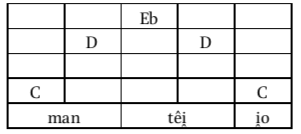
To illustrate further oblique settings, we can consider the setting of ὠιδαῖσι (DAGM 20.3f.). The setting of the circumflected syllable dâi̯ to a falling melism C Ab is parallel, but the pre-accentual rise and post-accentual fall in pitch are set to level tune, C C and Ab Ab, respectively. Those two settings are oblique. (Note that the word-final -n of Φοῖβον ὠιδαῖσι is resyllabified rightward to serve as the onset of the syllable n#ɔːi̯, where “#” marks the morphological word boundary.)
(11) ὠιδαῖσι (DAGM 20.3f.)
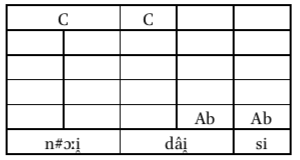
Opposing settings are rare in the Delphic hymns. The transition of Db to C in φερόπλοιο (DAGM 20.10) provides an example: the (expected) pre-accentual rise in pitch is set to falling melody.
(12) φερόπλοιο (DAGM 20.10)
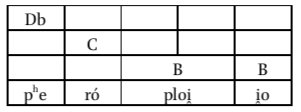
It is also worth illustrating how a word-final acute is preserved as such before an enclitic. This is reflected in the setting of τάν τε δορίσ[τεπτον (21.38), where we find a peak at acute-accented τάν, a post-accentual fall over the enclitic τε, after which there is a rise.
(13) τάν τε δορίσ[τεπτον (21.38)

5. Musical troughs in the Delphic hymns
All else being equal, the putative low boundary tone Lω would cause the turning point between falling and rising pitch to be aligned with the end of the word or clitic-group, i.e. the with the final mora or syllable. Given the general correlation of tone and tune in the Delphic hymns, we should see the effects of a Lω there, if it existed. In the aggregate, the turning point between falling and rising melody should center around the final mora/syllable.
Let us define musical “troughs” as a single-note turning point between falling and rising melody, e.g. the note C in the sequence D C Db in (14), the setting of Ἅφαιστος αἴθε<ι> (20.11f.). In the aggregate, they should reflect turning points between falling and rising pitch in the language.
(14) Ἅφαιστος αἴθε<ι> (20.11f.)
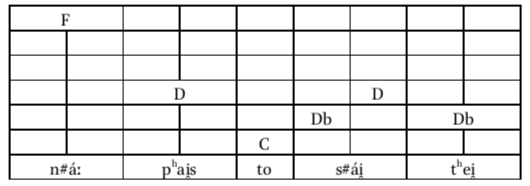
Eighth-note troughs may either be aligned with the sole mora of a light syllable (15a) or with one of two morae of a heavy syllable (15b). In both examples below, the trough is aligned with the word-final mora. As we will see, this is usually, but not always, the case.
(15) (a) Ὄλυμπον ἀνακίδναται (20.13f.) with the trough aligned with po
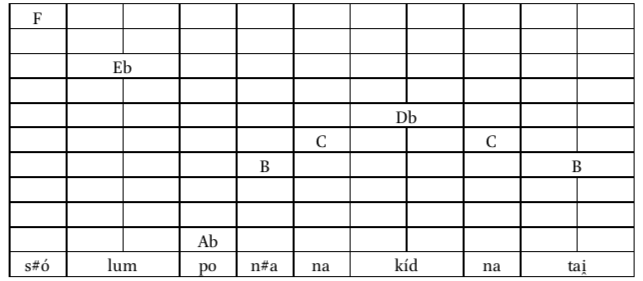
(b) αἰόλοις μέλεσιν (20.14f.) with the trough aligned with the second mora of loi̯s
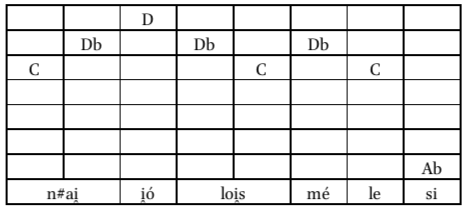
There are forty-nine eighth-note troughs in the Delphic hymns. Roughly two thirds are aligned with the final mora of a word (67%). Roughly a fifth occur just one mora earlier (22%), and 6% occur one mora later.[17] Prima facie, this looks like good evidence for the effect of a Lω: the turning point between falling and rising melody centers around the final mora.
Quarter-note troughs are always aligned with a heavy syllable. Here again, in the example (16), the trough is aligned with a final syllable; that is usually, but not always, the case.
(16) χρυσέα δ᾽ ἁδύθρους (20.15) with the trough aligned with aː
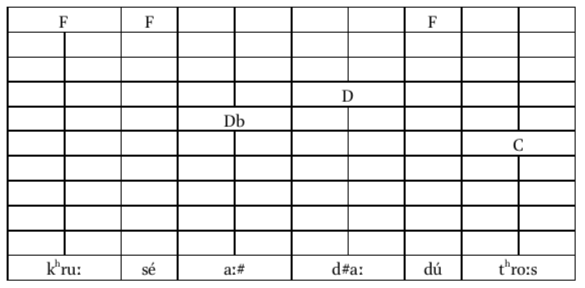
There are far fewer quarter-note troughs in the Delphic hymns: just thirteen. Eleven (69%) are aligned with the final syllable of the word, one (8%) occurs one syllable earlier, and three (23%) occur one syllable later, i.e. on the initial syllable of the following word.
6. Distinguishing accentual L from boundary Lω
We have seen that the troughs center around the word-final mora/syllable, which may point to the existence of a low boundary tone Lω. However, accentual low tones at the end of the word would have the same effect. As a next step, we should remove from the data set all words that have an accentual L on the final mora and check whether any evidence for Lω remains. In order to do so, I will use the following tonal analysis of ancient Greek accent.[18]
- circumflex = HL
- persistent (lexically inherent) acute = H
- recessive (phonologically derived) acute = HL*
Regarding HL*, I assume that the starred low tone aligns with the first mora of the word-final foot; the preceding H aligns one mora earlier and is graphically represented by the acute. The word-final foot is a moraic trochee, which consists either of one heavy syllable (1) or two light syllables (2); one word-final consonant is extrametrical.[19]
Let’s have a look at how this applies to the three most frequent accentual types in the Delphic hymns. Recessive proparoxytones (16x) are the most frequent type, e.g. θύγατρες = thúgatres ‘daughters:voc’ (17a). Because the accentual L* doesn’t occupy the final syllable, there is room for the putative Lω to have an effect (17b).
(17) (a) θύγατρες (20.2)

(b) θύγατρες (20.2)

This effect could be seen in the setting θύγατρες εὐώλ[ενοι] = thúgatres eu̯u̯ɔ́ːlenoi̯ ‘o fair-armed daughters’ (20.2), where the trough is aligned with the final syllable, i.e. one syllable after the accentual L*.
(18) θύγατρες εὐώλ[ενοι] (20.2)
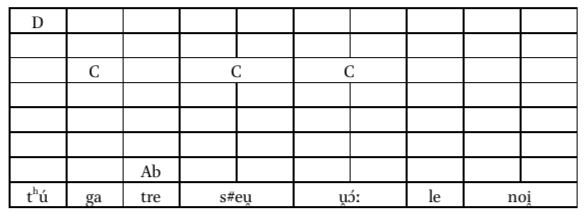
Recessive tri(+)syllabic paroxytones (9x) are the second most frequent type, e.g. ἐριβρόμου = eribrómoː ‘loud-thundering:GEN.SG’ (19a). Because the accentual L* doesn’t occupy the final mora, there is room for the putative Lω to have an effect (19b)
(19) (a)ἐριβρόμου (20.2)

(b) ἐριβρόμου (20.2)

This effect could be seen in ἐ[ρι]βρόμου θύγατρες = eribrómoː thúgatres ‘o (fair-armed) daughters of loud-booming (Zeus)’ (20.2), where the trough is aligned with the final mora, i.e. one mora after the accentual L*.
(20) ἐ[ρι]βρόμου θύγατρες (20.2)
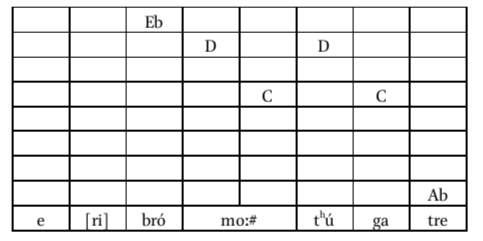
Persistent perispomena (7x) are the third most frequent type, e.g. τεχνιτῶν = tekhniːtɔ̂ːn ‘artists:GEN’ (20). Because the accentual L already occupies the final mora, there’s no room for a putative Lω to have an effect; it would presumably be delinked or deleted.
(20) τεχνιτῶν (21.20)

We will accordingly not attribute word-final troughs such as τεχνιτῶν ἔνοικος (21.20f.) to Lω, rather to the accentual L.
(21) τεχνιτῶν ἔνοικος (21.20f.)

When we remove the items with an accentual L on the word-final mora, we find that 63% of troughs are aligned with the final mora/syllable, 27% occur one mora/syllable earlier, and 10% occur one mora/syllable later.
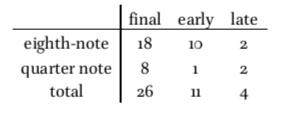
In other words, once we remove the effects of accentual L, the alignment of troughs remains roughly the same as in the overall picture (§5). The related accentual system of Vedic Sanskrit shows us that there is no need for troughs to be anchored to word end. If we encountered this in pitch tracks of a modern language, we would posit a low boundary tone.
6. Conclusion
On the assumption that the Delphic hymns provide something like pitch tracks for ancient Greek, the alignment of the musical troughs suggests that after an accentual L, continued to fall until the end of the word. The pre-accentual rise began right after that, i.e. with the first syllable of the following word. In my view, positing a Lω provides an attractive phonological “explanation” for that.
In the related accentual system of Vedic Sanskrit, the turning point between a post-accentual fall and a pre-accentual rise is not tied to word boundary (9). Contrast Greek musical troughs — presumably reflecting such turning points — where the preceding peak is relatively close, and the following peak is relatively distant, i.e. where the turning point in Vedic would occur within the second word of the bigram, e.g.
- δειράδα φιλένθεον (21.23) trough at da
- δεσπότι Κρησίων (21.35 Aeolic) trough at ti
There are at least two reasons to think that the Greek alignment of the turning point with word boundary is an innovation. First, it is attractive to connect the Greek turning point with other developments that clearly demarcated word-end in Greek:
- the restriction of the accent to the final two or three syllables, i.e. the “law of limitation;”
- the loss of word-final stops, e.g. *tód > tó = τό (cf. Vedic tád), *mélit > méli = μέλι (cf. μέλιτος, μέλισσα, and Hittite mi-li-it ‘honey’);
- the merger of word-final m and n, e.g. second declension accusative singular *-om > -on = -ον (cf. Old Latin -om, Latin -um, Vedic -am);
Garrett (2006:141) proposes that those changes are phonetically related via word-final laryngealization.[20] Since the other changes, e.g. the merger of word-final m and n > n, are clearly Greek innovations, the turning point, or as Garrett puts it, the fact that Greek “regularized falling pitch at the right edge of the word” (ibid.), would likely be an innovation as well. I suggest that the regularization is due to a low boundary tone.
On a more speculative note, that low boundary tone may well have earlier been associated with larger prosodic units (e.g. the intonational phrase) and later been generalized to smaller prosodic units, eventually the word or clitic-group.[21] The same has been argued for word-final devoicing and other phonological processes that are phonetically motivated at the end of utterances, but not at the end of smaller prosodic units.[22]
The second and less convincing reason is that Vedic seems to preserve the inherited accentual system better than Greek: it is linguistically plausible that the Greek accentual system developed from something very much like the Vedic system, but not vice versa.
7. Cura posterior
It must be noted that we are left with a small but solid set of examples where (1) the trough occurs one mora or syllable earlier and (2) it is aligned with an accentual low. There, it looks as if the Lω is not present, or ignored in the setting (cf. PGS 189ff.). These are a topic for future research.
Paroxytones
- ναίουσα Τριτωνίδος (20.10) i̯oː
- [τρ]ίποδα μαντεῖον (20.21) po
- δικόρυφον κλειτύν (21.2) ru
- μέλπετε δὲ Πύθιον (21.4) pe
- μελίπνοον δὲ Λίβυς (21.15) pno
- δεξάμενος ἀμβρόταν (21.18) me
- λη<ι>ζόμενος ὤλεθ᾽ (21.33) me
Properispomena
- βωμοῖσιν Ἅφαιστος (20.11f.) second mora of môi̯
- μαντεῖον ὡς εἷ[λες] (20.21) second mora of têi̯, μαντεῖον
Abbreviations
PGS = Devine, A. M., and Laurence D. Stephens. 1994. The Prosody of Greek Speech. Oxford.
DAGM = Pöhlmann, Egert, and Martin L. West. 2001. Documents of Ancient Greek Music. Oxford.
Works Cited
Allen, W. Sidney. 1973. Accent and Rhythm. Cambridge.
Allen, W. Sidney. 1987. Vox Graeca. A Guide to the Pronunciation of Classical Greek, 3rd ed. Cambridge.
Blumenfeld, Lev. 2004. “Tone-to-Stress and Stress-to-Tone: Ancient Greek Accent Revisited.” Proceedings of the Berkeley Linguistics Society 30.1:1–12.
Crusius, Otto. 1891. “Ein Liederfragment auf einer antiken Statuenbasis.” Philologus 50 (= N. S. 4):163–172; 576.
Crusius, Otto. 1894a. “Zu neuentdeckten antiken Musikresten.” Philologus 52 (= N. S. 6):160–200.
Crusius, Otto. 1894b. Die Delphischen Hymnen: Untersuchungen über Texte und Melodien. (Ergänzungsheft zum Philologus, 53). Göttingen.
Debrunner, Albert. 1929. Review of Laum 1928. Byzantinische Zeitschrift 29.1:50–55.
Devine, A. M., and Laurence D. Stephens. 1994. The Prosody of Greek Speech. Oxford.
Ehrlich, Hugo. 1906. “Zur griechischen Prosodie.” Zeitschrift für vergleichende Sprachforschung 39.4:571–586.
Ehrlich, Hugo. 1912. Untersuchungen über die Natur der griechischen Betonung. Berlin.
Erbse, Hartmut. 1960. Beiträge zur Überlieferung der Iliasscholien. Munich.
Galton, Herbert. 1962. “The Fixation of the Accent in Latin and Greek.” Sprachtypologie und Universalienforschung 15.1:273–300.
Garrett, Andrew. 2006. “Convergence in the Formation of Indo-European Subgroups: Phylogeny and Chronology.” In Phylogenetic Methods and the Prehistory of Languages, ed. Peter Forster and Colin Renfrew, 139–151. Cambridge.
Giessler, Joseph. 1923. “Prosodische Zeichen in den antiken Handschriften griechischer Lyriker.” Doctoral diss., Giessen.
Goldstein, David. 2014a. “Intonational Phrase.” In Encyclopedia of Ancient Greek Language and Linguistics. Vol. 2, G–O, ed. Georgios K. Giannakis, et al., 253–256. Leiden.
Goldstein, David. 2014b. “Phonological phrase.” In Encyclopedia of Ancient Greek Language and Linguistics. Vol. 3, P–Z, ed. Georgios K. Giannakis et al., 87–89. Leiden.
Gordon, Matthew. 2008. “Pitch Accent Timing and Scaling in Chickasaw.” Journal of Phonetics 36:521–535.
Gordon, Matthew, and Pamela Munro. 2007. “A Phonetic Study of Final Vowel Lengthening in Chickasaw.” International Journal of American Linguistics 73.3:293–330.
Gunkel, Dieter. 2014a. “Accentuation.” In Encyclopedia of Ancient Greek Language and Linguistics. Vol. 1, A–F, ed. Georgios K. Giannakis, et al., 7–12. Leiden.
Gunkel, Dieter. 2014b. “Sotera rule.” In Encyclopedia of Ancient Greek Language and Linguistics. Vol. 3, P–Z, Index, ed. Georgios K. Giannakis, et al., 296–297. Leiden.
Gunkel, Dieter. 2015 [April 2]. “Repulsive Low Tones and the Evolution of Ancient Greek Accentuation.” Program in Indo-European Studies, University of California, Los Angeles. https://www.academia.edu/28963634/Repulsive_low_tones_and_the_evolution_of_Ancient_Greek_accentuation.
Gussenhoven, Carlos. 2004. The Phonology of Tone and Intonation. Cambridge.
Ipek, Canan, and Sun-Ah Jun. 2013. “Towards a model of intonational phonology of Turkish: Neutral intonation.” Proceedings of Meetings on Acoustics 19:1–9.
Itô, Junko, and Armin Mester. 2017. “Ancient Greek Pitch Accent: Anti-Lapse and Tonal Antepenultimacy.” In New Developments in Phonological Research: Festschrift in Honor of Professor Haruo Kubozono’s 60th Birthday, ed. Shinichi Tanaka, et al., 2–18. Tokyo.
Jasanoff, Jay H. 2004. “Acute vs. Circumflex: Some Notes on PIE and Post-PIE Prosodic Phonology.” In Per Aspera ad Asteriscos. Studia Indogermanica in Honorem Jens Elmegård Rasmussen, ed. Adam Hyllested, et al., 247–256. Innsbruck.
Jasanoff, Jay H. 2017. The Prehistory of the Balto-Slavic Accent. Leiden.
McPherson, Laura, and Kevin M. Ryan. 2018. “Tone-Tune Association in Tommo So (Dogon) Folk Songs.” Language 94.1:119–156.
Miller, D. Gary. 1976. “The Transformation of a Natural Accent System: The Case of the Ancient Greek Enclitics.” Glotta 54:11–24.
Myers, Scott. 1999. “Tone Association and F0 Timing in Chichewa.” Studies in African Linguistics 28.2:215–239.
Myers, Scott. 2003. “F0 Timing in Kinyarwanda.” Phonetica 60:71–97.
Myers, Scott, and Jaye Padgett. 2014. “Domain Generalization in Artificial Language Learning.” Phonology 31: 399–433.
Nagy, Gregory. 2000. “Reading Greek Poetry Aloud: Evidence from the Bacchylides Papyri.” Quaderni Urbinati di Cultura Classica N. S. 64.1:7–28.
Ohala, John. 1993. “The Phonetics of Sound Change.” In Historical Linguistics: Problems and Perspectives, ed. Charles Jones, 237–278. London.
Pearl, Judea, and Dana Mackenzie. 2018. The Book of Why: The New Science of Cause and Effect. New York.
Pöhlmann, Egert. 1970. Denkmaler altgriechischer Musik. Nürnberg.
Pöhlmann, Egert, and Martin L. West. 2001. Documents of Ancient Greek Music. Oxford.
Probert, Philomen. 2003. A New Short Guide to the Accentuation of Ancient Greek. Bristol.
Probert, Philomen. 2006. Ancient Greek Accentuation: Synchronic Patterns, Frequency Effects, and Prehistory. Oxford.
Probert, Philomen. 2010. “Ancient Greek Accentuation in Generative Phonology and Optimality Theory.” Language and Linguistics Compass 4.1:1–26.
Revithiadou, Anthi. 2018. “Ancient Greek Pitch Accent: Extending Tonal Antepenultimacy to Enclitics and the σωτῆρα Words.” In Hana-bana (花々): A Festschrift for Junko Ito and Armin Mester, ed. Ryan Bennett, et al., 1–21. https://escholarship.org/uc/item/09m654fp.
Roussou, Stephanie, ed. 2018. Pseudo-Arcadius’ Epitome of Herodian’s De Prosodia Catholica. Oxford.
Ryan, Kevin M. 2019. Prosodic Weight: Categories and Continua. Oxford.
Sandell, Ryan. 2020 [December 15]. “Stress-to-Tone and Tone-to-Stress: On Stress, Tone, and Intonation in Ancient Attic-Ionic Greek.” Wiener Sprachgesellschaft, University of Vienna.
Schellenberg, Murray. 2012. “Does Language Determine Music in Tone Languages?” Ethnomusicology 56.2: 266–278.
Sturtevant, Edgar. H. 1940. The Pronunciation of Greek and Latin, 2nd ed. Philadelphia.
Trubetzkoy, N. S. 1939. Grundzüge der Phonologie. Prague.
Vessella, Carlo. 2016. “Boeotian Accentuation in the Ancient Editions of Boeotian Poetry.” Mnemosyne 69: 742–759.
Wackernagel, Jakob. 1896. “Das Zeugniss der delphischen Hymnen über den griechischen Accent.” Rheinisches Museum für Philologie, N. S. 51:304–305.
West, M. L. 1982. Greek Metre. Oxford.
Winnington-Ingram, R. P. 1955. “Fragments of Unknown Greek Tragic Texts with Musical Notation: II The Music.” Symbolae Osloenses 31:29–87.
Zhang, Jie. 2002. The Effects of Duration and Sonority on Contour Tone Distribution: A Typological Survey and Formal Analysis. New York.
Zhang, Jie. 2004. “Contour Tone Licensing and Contour Tone Representation.” Language and Linguistics 5.4:925–968.
Appendices
Gunkel_Appendix-1Gunkel_Appendix2
Notes
* A fellowship from the Center for Hellenic Studies greatly facilitated this research.
[1] The low boundary tone also figures in some unpublished work on ancient Greek accentuation, e.g. Gunkel 2015 and Sandell 2020.
[2] I leave aside why the acute is also realized as such at the end of the major phrase, on which see Allen 1973:248–251 and PGS 431f.
[3] Analyses that would have oxytones such as ἀγαθός enter the post-lexical phonology sans accent (Blumenfeld 2004, cf. also Trubetzkoy 1939:190, 215f.) do not explain why the acute drifts left when the host vowel is elided, e.g. the acute of ἀγαθά in τὰ δ’ ἀγάθ’ ἐκτελῆ γενέσθαι (Persae 218).
[4] For the grave as a lowered acute, see Ehrlich 1906:573f., 1912:250–265; Debrunner 1929:54f.; Sturtevant 1940:100f.; Winnington-Ingram 1955:62, 66; Erbse 1960:377f.; Allen 1973:245–248; Devine and Stephens 1994:180–183, 356–361, Probert 2003:16f., 20; 2006:59; 2010:2; Gunkel 2014a.
[5] For the grave as a deaccented acute, see Meillet 1905–6; Grammont 1948:388–390; Miller 1976:16–18; Nagy 2000:15 n. 19.
[6] For an overview of strategies to ameliorate the crowding of high … low tone sequences, see Gordon 2008 with references.
[7] Parallels for that type of retraction are documented in the phonological literature, e.g. for Chichewa (Myers 1999, 2003:91) and Chickasaw (Gordon 2008).
[8] On the question of whether the σωτῆρα rule applied in Doric, see Probert 2006:71 and Gunkel 2014b:297 with further references. The Boeotian evidence has since been revisited in Vessella 2016.
[9] Several later compositions are also of special interest, namely the Seikilos epitaph (DAGM 23, 1st or 2nd c. CE), the anonymous invocation of the Muse (DAGM 24), and three compositions of Mesomedes (DAGM 25, 27, 28, ca. 150 CE), a musician in Hadrian’s court.
[10] On the meter of the Delphic hymns, see West 1982:145f.
[11] Crusius (1891:171f., 1894a:173) was the first to note the correlation between tone and tune on the basis of the Seikilos epitaph. He formulated generalizations A and B on the basis of the additional material provided by the Delphic hymns in Crusius 1894b:113–123. The first formulation of generalization C is in Wackernagel 1896. See also West 1992:199 and Probert 2006:48.
[12] See McPherson and Ryan 2018:119–22 with references. Devine and Stephens (1994:162–171) situate the ancient Greek tradition against the backdrop of what was known about tone-tune association at the time.
[13] In order to illustrate the settings in the Delphic hymns in a way that is perspicuous for musicians and non-musicians alike, I use table-like figures with rows and columns. The text, broken down into syllables, is given in the bottom row. The row immediately above the text contains the lowest note(s) in the setting. Each row above that is a semitone higher (e.g. C, Db, D, Eb). The columns reflect the importance of the mora in Greek poetry and song. In the Delphic hymns, a light syllable is set to an eighth note, and a heavy syllable is set either to a quarter note (which is twice as long as an eighth note) or to two eighth notes. We refer to the setting of a heavy syllable to two eighth notes as a melism.
[14] Note that this includes one underlying tetrasyllable with an elided final syllable, i.e. ἀθώπευτ’ (20.24).
[15] See PGS 435ff.
[16] For the pre- and post-accentual pitch excursions, see Devine and Stephens 1994:185–9.
[17] The remaining two examples are difficult to classify. Each exhibits two troughs, the first of which falls into the classification above, and the second of which is surprising. In δικόρυφον κλειτύν (21.2), the first (classified) trough is on ru and the second (unclassified and surprising) trough is on the second mora of klei̯. It is possible that setting δικόρυφον to two melodic peaks (kó, phon) expresses the notion ‘twin-peaked’ musically (West 1992:294), and the surprising second trough follows from that. In Ἀτθίδ᾽ ἐπὶ γαλ[όφωι (21.14) the first (classified) trough is on de and the second (unclassified) trough is on the second mora of gaː. Two possibilities seem worth considering. (1) Limenius sets γαλόφωι so as to echo the δικόρυφον and thereby ties Mount Parnassus and Delphi to a corresponding hill in Athens. (2) The setting reflects Limenius’s analysis of the compound γαλόφωι ‘ridge’ as γᾶς λόφωι ‘earth’s crest’. The two are not mutually exclusive.
[18] Note that adopting a more “traditional” analysis, where all acutes (including recessive ones) are H, we would have more evidence for Lω. The more “modern” analysis, with recessive HL*, introduces a further accentual L, which can be responsible for word-final troughs, e.g. in disyllabic recessive forms such as ἔσχε.
[19] For an overview of the analyses that operate with HL* for recessive acutes, see Probert 2010.
[20] Garrett also dates the changes to the post-Mycenaean period, which I remain uncertain about.
[21] I thank Michael Weiss for pointing this out to me.
[22] See Myers and Padgett 2014 for a survey and references.
